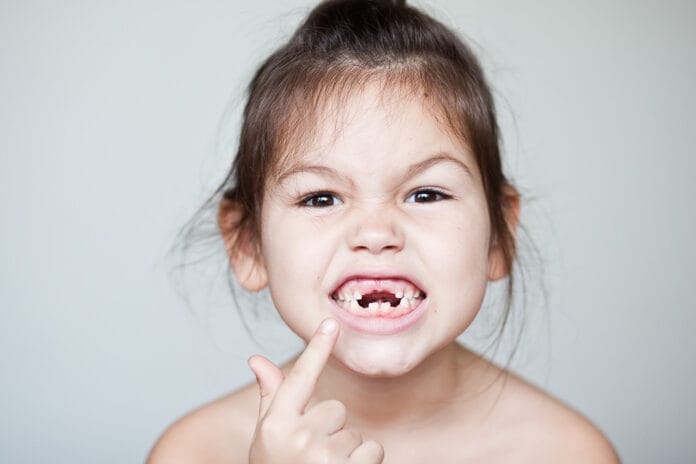Deciduous teeth (baby teeth) are essential for a child to learn to eat, form sounds, communicate in words, and properly form the stomatognathic system. Formerly known as the stomognathic system, the stomatognathic system comprises the temporomandibular joints, bones forming the oral cavity, soft tissue (gingiva, mucosa, tongue, cheeks, lips, and glands), muscles involved in chewing and swallowing, and teeth. Improper formation of the stomatognathic system can lead to a host of problems, including airway issues.
The early loss of the primary teeth has been known to disrupt the learning process. Toddlers learn so quickly that these disruptions can be detrimental to cognition and self-esteem, especially when the missing teeth are in front. The premature exfoliation of primary teeth may also cause crowding, ectopic eruption, or tooth impaction, which can result in malocclusion.
“Premature tooth loss can occur as a consequence of dental trauma, neonatal tooth extraction, early childhood caries, or periodontal problems, or it can be a manifestation of systemic disease. The most common causes of premature tooth loss are dental caries and trauma, but when these are excluded, it may be difficult to reach a diagnosis due to the lack of experience of dental practitioners.” When a toddler, or younger child, loses their deciduous teeth prematurely, without evidence of trauma, caries, or periodontal disease, then this symptom can point to a number of serious disorders that may be unknown to the child’s parents, all highlighted in Premature Loss of Deciduous Teeth as a Symptom of Systemic Disease: A Narrative Literature Review.
Early Loss of Primary Teeth Can Highlight Systemic Diseases
Researchers have discovered, so far, that early loss of primary teeth is a serious symptom of 16 various systemic diseases. Dental professionals should be aware of this information when working with younger children, and early diagnosis usually leads to a better prognosis.
1) Papillon–Lefèvre syndrome, or PLS, has an unknown origin but is caused by overly aggressive periodontitis and palmoplantar hyperkeratosis. The bones of the jaw can be calcified, and the kids have an increased chance of getting an infection through the holes where their teeth should be. This syndrome also causes thickening skin on the palms of your hands and the soles of your feet.
2) Congenital adrenal hyperplasia, or CAH, occurs when the body, in general, lacks cortisol. Besides increasing the aggression of periodontitis, it quickens the reabsorption of bone. Extra exposure to vitamin D is a great way to strengthen mineral density in the teeth of concern.
3) Langerhans cell histiocytosis, or LHC, causes intraoral lesions, severe inflammation, pain, and a radical increase in bone reabsorption. The radiographs of children with the disease show teeth that seem to be ‘floating in midair.’ Without an early diagnosis, this disease has led to death.
4) Mucocutaneous dyskeratosis causes enlarged and inflamed gingiva, which can become so severe that the gingiva covers the teeth that are affected. The teeth are severely mobile, and alveolar bone loss can occur.
5) Erythromelalgia attacks the periodontal ligament and increases the risk of loss of teeth.
6) Hajdu–Cheney syndrome, or HCS, is caused by a gene mutation that can deform the appearance of the face. It is marked by a highly arched palate, impaired eruption, and premature loss of teeth.
7) Short bowel syndrome, or SBS, is an intestinal disorder that disrupts vitamin and mineral absorption. Bone is easily, even spontaneously, broken, and sufferers usually have a diagnosis of osteoporosis and osteomalacia.
8) Cherubism is specifically an autoinflammatory bone disease existing only in the mandible and the maxilla. This leads to serious degradation of the bones or an overgrowth of bone that causes jaw abnormalities, displaced teeth, and swollen cheeks.
9) Hypophosphatasia causes tooth loss, but unlike other diseases, there is no root reabsorption. This is usually the first external sign of this extremely serious, though rare, genetic disease that will eventually cause an inordinate amount of pain. The disorder is usually accompanied by skeletal deformities, bowed legs, and a lower-than-average stature.
10) Coffin-Lowry syndrome is another rare disorder that causes early tooth loss, but this syndrome causes hypodontia, deformed crowns, a very narrow palate, and, of course, early tooth loss. The oral manifestations accompany such symptoms as relatively thick hands, an abnormally large nose, and short stature, just to name a few.
11) Chediak–Higashi syndrome causes excessive caries, especially in younger children. Reoccurring skin problems and a tendency towards respiratory illnesses can occur. Severe periodontitis, gingival inflammation, visible abscesses, and silver-white hair point directly to this syndrome.
12) The very rare cyclic neutropenia caused severe oral issues in a 2-year-old girl who presented with severe gingivitis, inflammation and bleeding. She only had three teeth left by the age of 5. This disease also causes fatigue, fever, and reoccurring respiratory issues. The periodontitis acts swiftly and seriously, and the alveolar bone loss can be significant.
13) Down syndrome can cause a loss of teeth, and the early formation of periodontal pockets can be especially damaging, but cognition in patients with down syndrome is a spectrum. There are individuals who don’t have the ability to maintain or complete a dental hygiene routine.
14) Acatalasia, otherwise known as acatalasemia, or Takahara disease, causes early tooth loss, intraoral necrosis, and tissue ulceration. The unusual oxidation of their blood causes it to react to hydrogen peroxide, turning blood brown but not bubbling.
15) Leukocyte adhesion deficiency, or LAD, type I is an immunodeficiency disorder affecting white blood cells, causing ulceration and necrosis while disallowing neutrophils to adhere to the vessel walls. Gingival hyperplasia is common, as well as recession and tooth migration.
16) Wiedemann–Steiner syndrome causes hypodontia, widely spaced teeth, malocclusion, and cleft palates. Patients will have developmental delays, skeletal deformities, and a lack of muscle tone.
While all of these diseases are rare, they can present in our patients as soon as they have teeth. Some may show no signs or symptoms until they are ten or older. This is why the recommendation that children have their first dental appointment by the age of one or when the first tooth erupts is essential. We can help these children if we notice and call attention to anything out of the ordinary, and having a baseline early on helps.
Of course, dental hygienists are not here to diagnose genetic diseases, and we definitely do not want to scare our patients by suggesting any particular problem. Still, we can refer patients to their pediatrician, where they can share their concerns. As we know, many systemic diseases and disorders present in the mouth, some very early on, making dental clinicians the first who may notice.
In closing, the researchers state, “Pathological mobility and premature exfoliation of primary teeth should always prompt clinicians to perform a thorough investigation. Proper diagnosis is not easily done and requires multidisciplinary collaboration between doctors and dentists. In such cases, complete medical investigations, such as blood and urine analysis, and sometimes gingival biopsy, should be performed to exclude underlying systemic disorders and select the best possible treatment option. In many cases of premature tooth loss, a group that includes an internist, pediatrician, pediatric dentist, orthodontist, and speech therapist needs to be engaged. Forming a group of people with different approaches and skill levels is very important, so that the case can be viewed from different perspectives. A collaborative practice, shared roles and responsibilities, and, most of all, communication among professionals are necessary to achieve long-term therapeutic success.”











